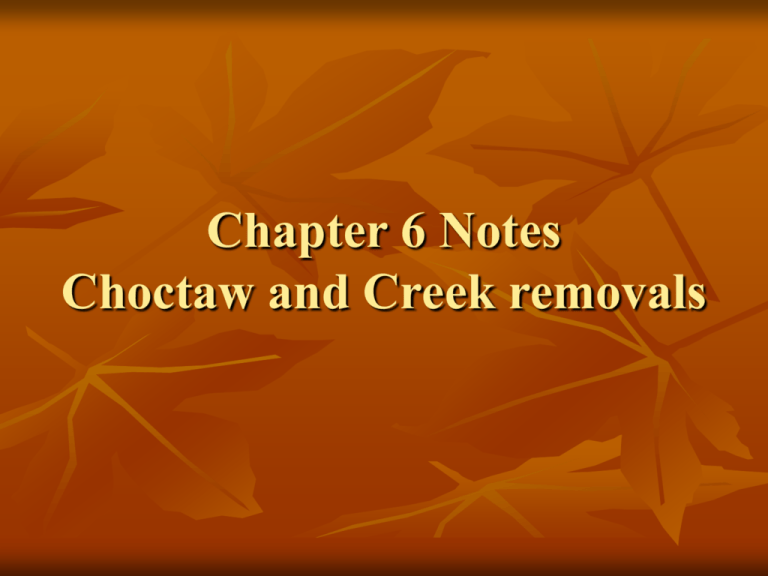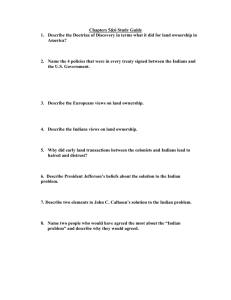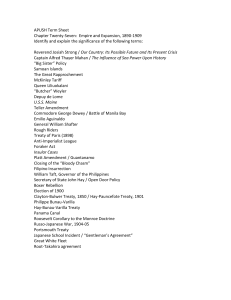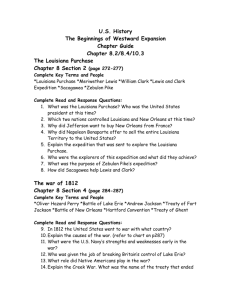oh-chapter 6 - 7 lecture
advertisement

Chapter 6 Notes Choctaw and Creek removals Louisiana Purchase - made the Mississippi river area the “answer to Indian problem” by some Still…land hungry whites would cross the river area and harass and still obtain land John C. Calhoun, Secretary of War Was the “creator” of Indian removal as the answer to Indian problem He advocated education before removal “Civilized” The Choctaws made swift progress in being educated and civilized Calhoun decided he would focus on them for first removal Oct 18, 1820 Choctaw leaders and the Indian Commission signed “Treaty of Doak’s Stand” This was the first removal treaty signed w/Choctaws They would cede 5 million acres in the east for 13 million acres west and financial assistance in re-locating Treaty of Dancing Rabbit Creek Signed on December 27, 1830 Would firmly establish gov’t policy on Indian Removal 11 total provisions Indian Removal Act Congress passed in May, 1830 Choctaws accepted gifts for land and felt they had “put one over on the U.S. Gov’t First party of 4,000 Choctaws were moved to Indian Territory in Oct, 1831 (First of three removals, met with a lot of hesitation) Dissension occurred among the Creeks Lower Creeks- Mixed blood who were led by McIntosh family. Upper Creeks- Led by Opothleyahola William McIntosh helped pass the law in 1811 requiring the death to anyone who sold off tribal lands without consent of the council Passed the Treaty of Indians Spring on Feb 12, 1825 Creek council disagreed and a death sentence was carried out against him John Quincy Adams learned of the hostility towards the Creeks, and ordered a New Treaty Invited the tribal chiefs to Washington to discuss. Indian Springs Treaty declared invalid New Agreement called for cession of Creek lands in Georgia and arranged for McIntosh followers to remove to the new lands Chapter 7 Trail of Tears The Chickasaws were the most prosperous out of the SE tribes. (Also, adjusted to white ways of life the quickest) Treaty of Pontotoc (1832) moved Chickasaws to temporary locations on their former lands while government sold their property to eager white buyers Treaty of Doaksville Signed on Jan 17, 1837 Chickasaw leaders and Choctaw leaders signed this agreement Choctaws agreed to sell portion of the central and western areas of their nation in Indian Territory to the Chickasaws Cherokees were the first the give the western journey a name “The Trail of Tears” or “Trail Where They Cried” This name referred to all the removals of the 5 Civilized tribes, because of suffering and death rates Gold was found in Georgia Cherokees were literally routed from their homes, their woman raped, the men beaten. Georgia Guard sent to protect the peace, but did their own cruel or evil acts Cherokee leaders Major Ridge, John Ridge, Elias Boudinot, and Principal Chief John Ross held firm that Gov’t should honor it’s promise to leave Cherokees alone On December 29, 1835 at New Echota; Boudinot, Mjor Ridge, and John Ridge signed a treaty to remove to the West (some think they were bribed of tricked) Cherokees made efforts to avoid removal. Such as, welcomed whit missionaries, become literate and “assimilate” to white customs Chickasaws efforts to avoid removal included: accepting Christianity, become more adapt to business Chickasaws, in order to become more independent, did the following Engage in vast farming ventures, Build transportation and lodging services for travelers, demand money for payment instead of goods “became business people” Winfield Scott was sent to Georgia and Tennessee area to take charge of the 7,000 troops to speed up removal. The Treaty of New Echota resulted in in the Cherokee removal (The three leaders who signed this treaty were later killed)







